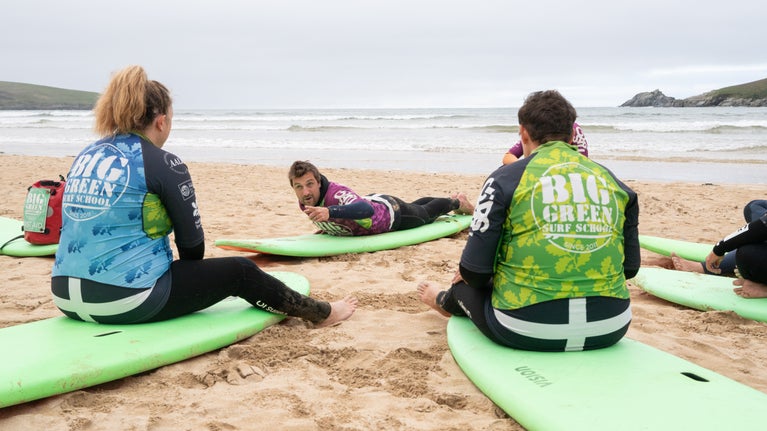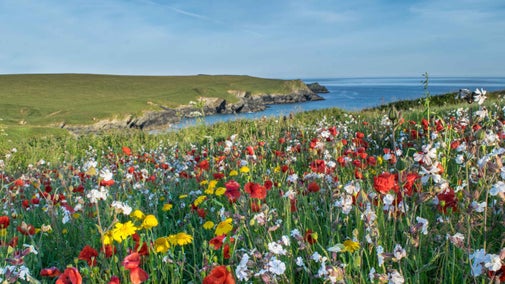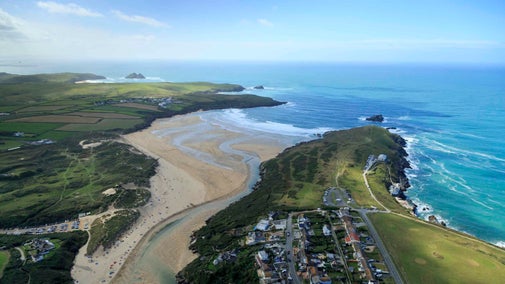
Discover more at Crantock Beach
Find out how to get to Crantock Beach, where to park, the things to see and do and more.

Crantock beach is an expanse of sand backed by often sheer dunes. There's plenty to do on your visit, from a relaxing walk along the coast to surfing amongst the waves.
Please take extra care around the dune system at Crantock Beach. Stay clear from the base of the sand cliffs and do not allow children to play near them. Only swim when RNLI lifeguards are on duty.

Big Green Adventures at Crantock offers lessons in surfing, stand-up paddleboarding, kayaking, bodyboarding and coasteering, as well as hire. This is an independent activity centre and the only outdoor provider licensed by the Trust to operate at Crantock. They offer lessons and hire from their base in the National Trust car park.
Visit the Big Green Adventures website
Pay a visit to Crantock Beach and you can start ticking off your list of 50 things to do before you're 11¾. Have a go at jumping over waves or take a swim in the sea - don't forget to follow the advice from the lifeguards. You could also explore the nearby footpaths using a map and compass or look out for a number of different sea birds.

Crantock sits on the South West Coast Path and there are a number of walks to explore. You can head towards Penpol and Newquay or south in the direction of West Pentire and Porth Joke.
Crantock Beach is a broad sand-dune backed strand between the twin headlands of Pentire Point East and Pentire Point West, Pentire meaning headland. On the west side of the beach the deep cleft of Pipers Hole is a sanctuary for fulmars and jackdaws which can best be seen nesting from the coast path.
At low tide the first cave can be entered (be sure to check the tide times first), where you can see a flat slab with the outline of a female figure and a few lines of verse carved into it. A small, incised horse can also be seen cut into the slab. These carvings are the work of a local man, Joseph Prater, and are thought to have been completed in the early 1900s.
The Gannel estuary passes Trerice a few miles inland, and separates Crantock from Pentire Point East and the town of Newquay. Until late in the last century the mouth of the Gannel was used by shipping. The demise of trading was caused partly by the development of Newquay harbour and the silting up of the narrow channel by banks of sand.
You can catch glimpses of the industrial past by exploring the local footpaths.
Limestone and coal were also barged up Penpol Creek where a ruined lime kiln can be seen. A walk along the western foreshore of the wooded creek at low tide will reveal small quays, flights of steps, mooring rings and chains. Ships were built on the northern shore just below Tregunnel.
About 20 yards east of the slip at Fern Pit the slatey rock is scored with several dozen holes, each the size of a dinner plate. No plausible reason has ever been agreed on for this phenomenon, which may be natural or man-made.

Porth Joke, known locally as Polly Joke, is a small cove nestled between Holywell and Crantock. Untouched by commercialism, the beach is a stone’s throw from West Pentire. If you visit during late spring or early summer, you'll be rewarded with a glorious display of wildflowers on the clifftops.
Please be aware this beach is not lifeguarded and there is a risk of rockfalls so keep away from the cliffs. There are no public toilets here.
Cattle and sheep can graze on the slopes above Porth Joke at West Pentire throughout the year. Please look out for signs about grazing animals that might be on the footpath ahead, particularly if you're out walking your dog or accessing the coast from the car park there (not National Trust).

Find out how to get to Crantock Beach, where to park, the things to see and do and more.
How to make your visit to Crantock Beach a safe and enjoyable one.

Crantock Beach is a one pawprint rated place, and a great place for a walk with your dog. Take a look at these top tips to make the most of your visit.

Find out about the coastal wild flowers growing at West Pentire.

Learn about the coastal changes taking place at Crantock Beach with its dynamic dune system.

Try out the ‘50 things to do before you’re 11¾’ activities children can enjoy by the sea, from paddling or swimming, to catching crabs and skimming stones.

While canoeing and kayaking are great ways to experience nature and keep fit, they can be dangerous if you don't follow the guidelines. Learn how to stay safe with our advice and guidance.
